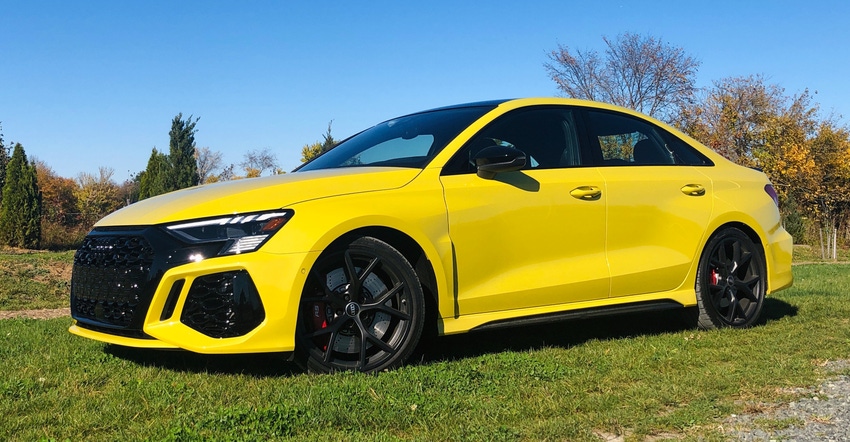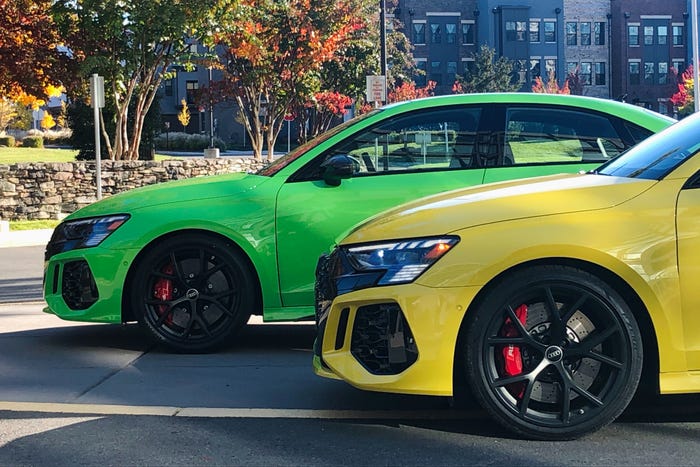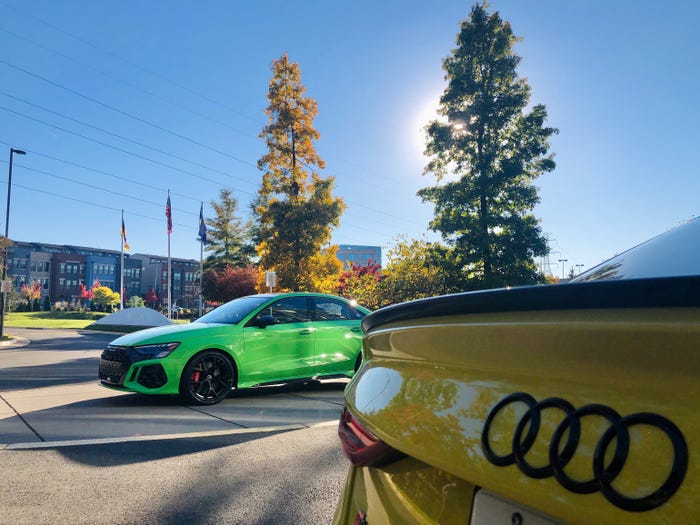Audi RS 3 Delivers Five-Cylinder Thrills
This last-of-the-breed sport sedan delivers the visceral excitement that reminds us what is lost with electrification.

As the age of combustion enters its twilight, we are faced with a series of “lasts,” as electrified models replace combustion cars. In the case of Audi, we’re looking at the brand’s signature five-cylinder engine riding high as it heads off into the sunset in the 2022 Audi RS 3.
Audi launched its family of five-cylinder engines in pursuit of adding power to its four-cylinder engines in a package that would still fit under the hood of its longitudinal front-drive cars. It debuted in the 1976 Audi 100, which came to the U.S. as the Audi 5000. That engine displaced a scant 2.1 liters and produced 136 horsepower, and its power boost over the four-cylinder was seen as crucial in the U.S. market, where buyers prefer torque-sapping automatic transmissions.
But while the five-cylinder was launched to reinforce the torque of Audi’s luxury sedan, the engine’s image changed course when the company employed it in the 1980 Quattro rally car and subsequently won the World Rally Championship with this combination of five-cylinder power and all-wheel-drive traction in 1983.
That was using an all-aluminum, 306-horsepower race-tuned version of the five-cylinder engine. Today, the 2022 Audi RS 3 sit in showrooms awaiting customers with its aluminum 2.5-liter turbocharged delivering 401 horsepower for everyday enjoyment. As the last edition of the engine, this marks the zenith of its development and the RS 3 is the last opportunity for drivers to enjoy the unique experience of its five-cylinder soundtrack.
The RS 3 is the hot-rod version of Audi’s A3 compact sedan, and with its high-performance drivetrain, it rockets to 60 mph in just 3.6 seconds and has a top speed of 180 mph. I didn’t get to experience that top speed, but the RS 3’s acceleration on country roads, and the accompanying exhaust note, is truly inspiring.
I had the good fortune to see the Group 44 Audi Quattro race in 1989, and while the RS 3 shares the race car’s five-cylinder exhaust sound, it does lack the distinctive whistle of the race car’s turbo boost-relieving pop-off valve when braking for corners. Which is surely a good thing for most drivers!
Instead, today’s drivers get cool advances like the RS 3’s torque splitter, which increases drive torque to the outside rear wheel to significantly reduce understeer during sporty driving. For example, if the driver pushes through a fast left turn, drive torque is immediately distributed to the right wheel. This is best experienced on a race track, but you can enjoy its benefits on a twisty road too, where we noticed none of the understeer that is typical on corner turn-in for all-wheel-drive cars.

The torque splitter responds to the driver’s selection of drive modes, producing these results:
Comfort mode – prioritizes front axle efficiency
Auto mode – offers balanced front/rear torque distribution
Dynamic mode – offers as much torque as possible to rear axle
RS Torque Rear mode – allows for controlled drifts
RS Performance mode – designed for track use to minimize understeer and oversteer in fast cornering
Audi ditched the previous RS 3’s magnetically adjustable shock absorbers for new computer-controlled shocks with active valving, claiming improved response, but without a back-to-back track test, the difference wasn’t discernable in routine sporty driving.

What is discernable, subtly, is the RS 3’s winking self-identification through the driver’s side headlight LEDs, which spell out R, S, and 3 as the driver approaches the car. Most people won’t notice that. But they will notice the RS 3’s available color palette, which includes the vibrant Kyalami Green (named for a South African race track), Kemora Gray (named for a Finnish race track), Daytona Gray (named for, well, Daytona!), Glacier White, Mythos Black, Python Yellow, Tango Red, and Turbo Blue.
I had the good fortune to drive the photogenic Python Yellow car, as the Kyalami Green was a static display for photography only. With a starting base price of $58,900, the RS 3 could look expensive for a compact sedan. But considering the advanced technology like the torque splitter and the massively powerful engine, it seems like a performance bargain. And the opportunity to own a true last-of-its-kind is priceless!
About the Author(s)
You May Also Like





